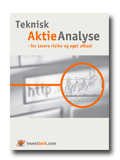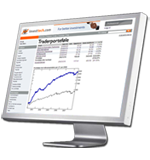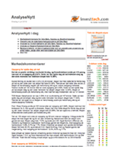try to get document id 74446
try to get document id 74446
try to get document id 74446
Investtech Research: Trend signals remain reliable
Published 18 August 2023
Previous research, based on data from the period 2008-2020, showed that buy signals from trends on average gave excess return compared to the rest of the market. The same analyses have now been conducted using data from the period 2020 - 2022. The results are consistent. Buy signals from trends in the period 2020 - 2022 have, on average, provided strong excess return compared to the rest of the market.
Trends are one of the most central elements within technical analysis. They are visual and intuitive, describing the direction in which a stock or the market is moving. An upward trend indicates persistent and increasing optimism among investors, often as a result of a stream of positive news around the stock. According to technical analysis theory, it is a buy signal when the price is in a rising trend, breaks upwards from a rising trend, and breaks upwards from a horizontal trend. A break downwards from a rising trend is also considered a buy signal, but less strong than when the price is within the trend.
We have previously observed the price movements that have followed buy signals from trends in Investtech's price charts for the Norwegian, Swedish, Danish, and Finnish stock exchanges. Based on signals from the period 2008 - 2020, we concluded that buy signals from trends, on average, gave excess return compared to the rest of the market.
As a follow-up to this research, we have now examined trend signals in medium-term charts for the period 2020 - 2022.
Stocks in rising trends
The chart below shows average price development following buy signals from rising trends identified in Investtech’s medium term price charts in the Nordic markets. The signals are triggered on day 0. Only days when the exchange is open are included, so 66 days equal approximately three months. The thick blue line shows the development of buy signal stocks. The shaded areas are the standard deviation of the calculations. The thin blue line shows benchmark development in the same period as the buy signal stocks.
Figur 1: Buy signal from rising trend, medium term, the Nordic markets combined 2020-2022. Thick blue line is signal stocks, thin blue line is benchmark index.
We observe that stocks in a rising trend (buy signal) have risen in the following period. The increase has been quite steady throughout the three-month period, and it has been significantly better than benchmark. After 66 days, the stocks with buy signals have on average increased by 5.6 percent, while bencmark has on average risen by 3.5 percent in the same period. This results in an average excess return of 2.0 percentage points after 66 days.
| Return and relative return after 66 days | Norway | Sweden | Denmark | Finland | Weighted average |
| Buy signal | 7.1 % | 5.1 % | 5.4 % | 5.4 % | 5.6 % |
| Benchmark index in same period | 3.4 % | 3.6 % | 4.1 % | 3.0 % | 3.5 % |
| Excess return buy signal | 3.7 pp | 1.5 pp | 1.3 pp | 2.3 pp | 2.0 pp |
Converted into annualized figures, the buy signals have on average provided 8.9 percentage points excess return vs benchmark. For the period 2008-2020, the corresponding figure was 6.5 percentage points. The table below shows annualised returns based on the 66-day figures for each of the Nordic countries, as well as a weighted average for the Nordic region.
| Annualised return (based on 66 day figures) | Norway | Sweden | Denmark | Finland | Weighted average |
| Buy signal | 29.8 % | 20.8 % | 22.2 % | 22.2 % | 23.0 % |
| Benchmark in same period | 13.5 % | 14.4 % | 16.5 % | 12.2 % | 14.1 % |
| Excess return buy signal | 16.3 pp | 6.5 pp | 5.7 pp | 10.0 pp | 8.9 pp |
pp = percentage points, i.e. the arithmetic difference of the percentage returns. Annualised figures are calculated by repeating the 66-day figures for one year, assuming an average year has 252 stock exchange days.
Buying stocks in a rising trend is considered to be a good strategy.
Other buy signals from trends
Similar analyses were performed for the other buy signals based on trends, i.e., when the stock price breaks upwards from a rising trend, breaks downwards from a rising trend, or breaks upwards from a horizontal trend. These signals have also on average given positive excess return. The research results show that in the period 2020-2022, these signals yielded an average annualised excess return of 8.4 percentage points, 3.3 percentage points, and 19.1 percentage points, respectively.
Summary
Buy signals from trends in the period 2020-2022 have on average exhibited a significantly stronger performance than the rest of the market over the next three months.
| Signal | Annualised excess return |
| Rising trend | 8.9 pp |
| Rising trend breaking upwards | 8.4 pp |
| Rising trend breaking downwards | 3.3 pp |
| Horizontal trend breaking upwards | 19.1 pp |
Buy signals from trends can be useful signals in a trading strategy for the Nordic market.
Keywords: h_THorBrU,h_TR,h_TRBrD,h_TRBrU.
Skrevet af

Analytiker
i Investtech
Research reports (in Norwegian only):
Trends - signal statistics Nordic countries 2008 - 2020
Trends - signal statistics Nordic countries 2019 and 2020
Previous research on trends:
The Trend Bible
Investeringsanbefalinge(r)n(e) er udarbejdet af Investtech.com AS ("Investtech"). Investtech garanterer ikke for fuldstændigheden eller rigtigheden af analysen. Eventuel eksponering i forhold til de råd / signaler, som fremkommer i analyserne, står helt og holdent for investors regning og risiko. Investtech er hverken direkte eller indirekte ansvarlig for tab, der opstår som følge af brug af Investtechs analyser. Oplysninger om eventuelle interessekonflikter vil altid fremgå af investeringsanbefalingen. Yderligere information om Investtechs analyser findes på infosiden.
Investeringsanbefalinge(r)n(e) er udarbejdet af Investtech.com AS ("Investtech"). Investtech garanterer ikke for fuldstændigheden eller rigtigheden af analysen. Eventuel eksponering i forhold til de råd / signaler, som fremkommer i analyserne, står helt og holdent for investors regning og risiko. Investtech er hverken direkte eller indirekte ansvarlig for tab, der opstår som følge af brug af Investtechs analyser. Oplysninger om eventuelle interessekonflikter vil altid fremgå af investeringsanbefalingen. Yderligere information om Investtechs analyser findes på infosiden.


 Oslo Børs
Oslo Børs Stockholmsbörsen
Stockholmsbörsen Københavns Fondsbørs
Københavns Fondsbørs Helsingin pörssi
Helsingin pörssi World Indices
World Indices US Stocks
US Stocks Toronto Stock Exchange
Toronto Stock Exchange London Stock Exchange
London Stock Exchange Euronext Amsterdam
Euronext Amsterdam Euronext Brussel
Euronext Brussel DAX
DAX CAC 40
CAC 40 Mumbai S.E.
Mumbai S.E. Commodities
Commodities Currency
Currency Cryptocurrency
Cryptocurrency Exchange Traded Funds
Exchange Traded Funds Investtech Indices
Investtech Indices


